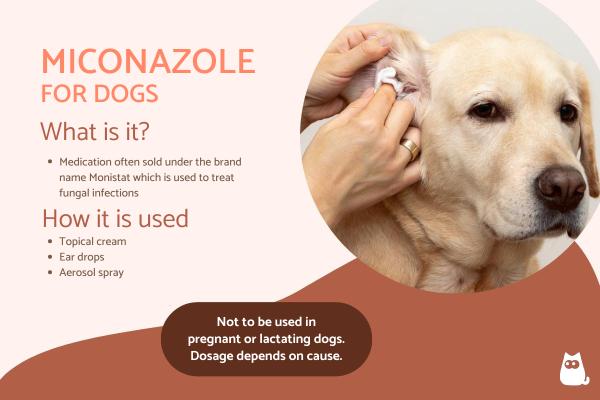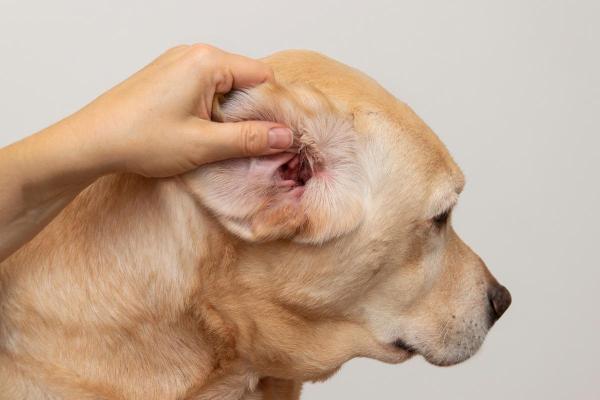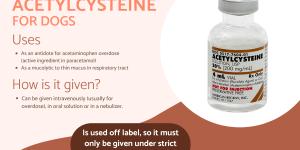Miconazole for Dogs - Uses and Dosage



See files for Dogs
Miconazole for dogs is the active ingredient of certain medications which is classified as an antifungal. It is considered a fungistatic and fingicidal drug which acts on fungi and yeasts which can proliferate in various tissues of the canine body. Although minimal, research suggests there is also some action against gram-positive bacteria. Miconazole can be administered to treat a range of fungal diseases which affect dogs. Preparations of the medication are varied, but it is generally for external use in the form of drops. It can also be incorporated to create medicated products such as shampoos, sprays and topical creams.
At Animal Wised, we take a closer look at the uses, dosage and side effects of miconazole for dogs. We see why your veterinarian might prescribe this medication, as well as some of the cases where its use is contraindicated.
What is miconazole for dogs?
Miconazole is a compound that is used as the active ingredients in various medications, although it is often sold under the brand name Monistat. It belongs to the group of drugs known as N-substituted imidazole derivatives and is responsible for inhibiting newly synthesized ergosterol. This is a lipid found in the essential membrane and is synthesized by fungi.
When ergosterol is not synthesized, the membrane cannot perform the numerous functions it must perform and culminates in the death of the fungus. This is why the spectrum of action of miconazole covers practically all fungi and yeasts which can infect dogs.
The activity of miconazole against bacteria has been recorded, with some efficacy against gram-positive bacteria, but none seen for gram-negative bacteria[1]. However, it is important to know that its use against bacteria is relatively very low and it is not commonly prescribed by veterinarians to treat bacterial infections.
Products for dogs that contain miconazole as an active ingredient generally include it in combination with others such as:
- Chlorhexidine in shampoo format: serves as an antimicrobial aid with a dual action of both active ingredients. Our related article explains whether chlorhexidine is safe for dogs.
- Polymyxin B in ear drops: for ear infections as it is effective against Gram-negative bacteria in which it causes bacterial autolysis. The miconazole can also help with fungal proliferation.
Miconazole for dogs uses
Miconazole for dogs is marketed in various formats. Common preparations include topical creams, ear drops or medicated shampoos. There is also a miconazole spray for dogs which comes as an aerosol. This drug acts against fungi and yeast. Its bacterial use is limited and there is insufficient study for its efficacy against bacterial diseases. the type of miconazole for dogs prescribed by the veterinarian will depend on its format.
As stated above, miconazole is used topically. Spray aerosol miconazole is used to treat large areas of skin in the dog, while creams might be used for more localized infections. The topical format for dogs is used to treat the following:
- Dermatophytosis (ringworm): caused by fungal strains such as Microsporum canis, Microsporum gypseum and Trichophyton mentagrophytes.
- Mycosis: due to the yeast Mallassezia pachydermatis.
- Interdigital dermatitis: fungal infection of the paw pads.
- Skin fold fungal infections: these are more common in wrinkly dog breeds such as the Pug or Shar Pei.
- Onychomycosis: fungal nailbed infection.
- Vaginitis: vulvovaginal candidiasis and other fungal infections of the reproductive organs.
Miconazole is also sold in a drops preparation, usually prescribed for use in the ear canal. This is when the dog has a fungal infection which results in otitis externa, commonly by fungi such as Malassezia pachydermatis. Miconazole formulated in the form of a shampoo is used for the treatment of dermatophytosis or ringworm caused by Microsporum canis twice a week in combination with griseofulvin. This helps to improve clinical conditions and reduce environmental contamination by these fungi.

Miconazole dosage for dogs
Dosage of miconazole for dogs will depend on the format and the problem needing treatment. Although miconazole is sold as both an over-the-counter and prescription-only medications, it is always advised to use it only under veterinary guidance. This is especially important in terms of diagnosis since fungal infections can have similar symptoms to other negative health conditions in dogs. The following dosages are common for miconazole:
- Cream or drops miconazole: it should be applied with a thin layer or a few drops over the entire extent of the wound or injury two to three times a day. Treatment lasts for about four weeks and up to 48 hours after the symptoms disappear.
- Ear drops miconazole: they should be applied to the external ear canal or canal once clean, administering three to five drops every 12 hours until the symptoms resolve. In difficult cases, symptoms can last two to three weeks.
- Miconazole shampoo for dogs: it is applied twice a week until the symptoms improve. It is then reduced to once a week to keep the ringworm condition under control.
Due to the contact with the ground, fungal infections are relatively common in a dog's paw pads. Learn more about the causes and treatment of paw pad fungus in dogs with our related guide.
How to give miconazole to dogs
As we have mentioned previously, the dosage will depend on the preparation. This influences how miconazole is administered to dogs in general:
Topical cream miconazole for dogs
Miconazole for dogs in cream format is applied directly topically to the entire extent of the dog's injury. A thin layer is applied two to three times a day for a month. Application ceases 48 hours after the disappearance of the lesions symptomatic of the injury.
Miconazole drops for dogs
Shake before use. Trim the dog's hair around the affected area and clean. Apply directly to the skin or ear canal. Apply an amount of about three to five drops twice a day for seven to fourteen days. In the worst cases, it can be extended to three or four weeks, depending on when the clinical signs in the dog disappear. After application, the ear or skin should be massaged to encourage the penetration of the product.
Miconazole shampoo for dogs
Finally, miconazole in dog shampoo format should be applied to wet hair. Apply drops in various points of the dog's coat to distribute it throughout the skin, making sure that it is also applied under the tail, around the lips and between the paws. The shampoo should be left for some minutes to take effect and then it should be rinsed with clean water. The fur needs to be dried after bathing since allowing the dog to be wet for prolonged periods encourages fungus proliferation.
Side effects of miconazole for dogs
Like any active ingredient or drug, miconazole can cause side effects in dogs. The most common side effect that may appear is burning or irritation at the application site of the product.
When miconazole for dogs is combined with corticosteroids and is used for a long period of time, the following may appear which may increase the risk of secondary infections:
- Thickened skin
- Delayed wound healing
- Adrenal suppression
- Local immunosuppression
On very rare occasions, miconazole for dogs in medication may be associated with the development of deafness, especially if an elderly dog has been treated. In the case of miconazole in shampoo format, when a dog with atopic dermatitis is treated, it may develop an itching or redness or erythema reaction.
Contraindications of miconazole for dogs
When combined with other active ingredients, miconazole for dogs must be used with caution. Your veterinarian will need to assess the following contraindications:
- It should not be used in pregnant or lactating dogs due to the risk of oral ingestion of the active ingredient after licking the treated area.
- Do not use miconazole ear drops if the dog to be treated has a perforated eardrum because polymyxin B is ototoxic.
- Do not use in dogs with large open skin lesions or wounds with poor healing in the case of combination with corticosteroids.
- Do not use in dogs with allergies or hypersensitivity to some of the active ingredients or excipients, as well as with known resistance to any drug.
Learn more about the causes, treatment and other factors involved in treating both internal and external fungal infections in dogs.
This article is purely informative. AnimalWised does not have the authority to prescribe any veterinary treatment or create a diagnosis. We invite you to take your pet to the veterinarian if they are suffering from any condition or pain.
If you want to read similar articles to Miconazole for Dogs - Uses and Dosage, we recommend you visit our Medicine category.
- Spanish Agency for Medicines and Health Products. Technical sheet for Mitex ear drops and skin suspension for dogs and cats.
- Spanish Agency for Medicines and Health Products. Technical sheet of Malaseb shampoo for dogs and cats.




